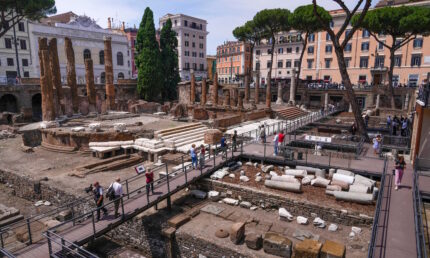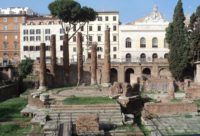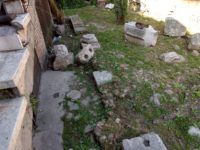 The site in the historic center of Rome where Republican temples and Pompey’s Theater were the backdrops to the assassination of Julius Caesar in 44 B.C. has opened to the public for the first time. The cats who have long dominated its decrepit walkways and piles of disorganized ancient stones have a much tidier, informative and navigable new setting from which to blink lazily at their fans.
The site in the historic center of Rome where Republican temples and Pompey’s Theater were the backdrops to the assassination of Julius Caesar in 44 B.C. has opened to the public for the first time. The cats who have long dominated its decrepit walkways and piles of disorganized ancient stones have a much tidier, informative and navigable new setting from which to blink lazily at their fans.
Funded by luxury jewelers Bulgari, the redevelopment of the archaeological site began in 2021 with the aim of making the sunken square in the middle of one of Rome’s busiest piazzas a walkable, coherent space instead of a litter-strewn, weed-choked jumble of broken stones and unidentifiable ruins.
The promotion and press leans heavily on its being the site where Caesar was assassinated, but that’s something of a fudge. Only a tiny sliver of Pompey’s massive theater complex on the Campus Martius, completed in 55 B.C., is visible at the Largo di Torre Argentina. It’s a section of a tufa base under the edge of the Curia Pompeiana where the Roman senate temporarily held meetings after a fire in 53 B.C. devastated the senate house in the Forum. The entrance to the curia that was the actual scene of the crime lies beneath the Teatro Argentina, an 18th century opera house that overlooks the archaeological site from across the street.
 The remains of the structures that give the Area Sacra its name are much older than the theater, ranging in date from the 4th to the 2nd century B.C. There are four temples, dubbed A-D because nobody is sure which deities they were dedicated to. Temple C is the most ancient and is believed to have been devoted to the fertility goddess Feronia. Temple A was next, built in the mid-3rd century B.C. Temple D dates to 2nd century B.C. and is the largest of the four. The temples were damaged by a fire that devastated the city in 111 B.C. A new floor was installed over the rubble and Temple B was built after the fire. B is the only circular temple in the Area Sacra. The travertine slab flooring you see now was installed by the emperor Domitian in 80 A.D. after yet another fire.
The remains of the structures that give the Area Sacra its name are much older than the theater, ranging in date from the 4th to the 2nd century B.C. There are four temples, dubbed A-D because nobody is sure which deities they were dedicated to. Temple C is the most ancient and is believed to have been devoted to the fertility goddess Feronia. Temple A was next, built in the mid-3rd century B.C. Temple D dates to 2nd century B.C. and is the largest of the four. The temples were damaged by a fire that devastated the city in 111 B.C. A new floor was installed over the rubble and Temple B was built after the fire. B is the only circular temple in the Area Sacra. The travertine slab flooring you see now was installed by the emperor Domitian in 80 A.D. after yet another fire.
The temples were abandoned in the 5th century and mined for construction materials. There is evidence of large tufa blocks having been reused within the former Area Sacra in the 8th and 9th centuries, but these were likely dwellings. A church was built in the 9th century and the remains of some of its 12th century alterations, including a Cosmati pavement, still survive.
The growth of the city eventually overwhelmed even the medieval structures and the Area Sacra was forgotten. It was rediscovered in 1926 during construction of new buildings. Crammed into the middle of modern Rome’s criss-crossing streets and tram lines, the temple area has never been set up for visitors to enjoy. People have had to content themselves with looking down into the pit from the modern street level.
The redesign now makes it possible for visitors to go down into the area and explore it via an accessible elevator and walkways. There are no barriers, fences or scaffolds obscuring the view. Everything is even on one plane so people with mobility aides can maneuver easily. Two new spaces have been opened up exhibiting an array of sculptural, architectural and funerary artifacts discovered at the site during the demolitions of the 1920s. Informational panels in Italian and English recount the history of the site from antiquity to the 20th century. Two large panels created for the vision impaired and blind include Braille descriptions and two 3D printed objects made from scans of the originals — a marble fragment with a relief of a bird pecking a fruit and the colossal head of a female cult statue.
 The new raised walkways, exhibition space, informational panels and lighting system will have no effect on the cats who have colonized the area since it was fully exposed in 1929. They will have the same free run of the place and their sanctuary is safe behind a wall on the Via Arenula side of the piazza.
The new raised walkways, exhibition space, informational panels and lighting system will have no effect on the cats who have colonized the area since it was fully exposed in 1929. They will have the same free run of the place and their sanctuary is safe behind a wall on the Via Arenula side of the piazza.